Preparation & Cooking Methods
Food was often roasted on a boucan, from which we get the word 'barbecue'. Food was also roasted in the embers of a fire. The ash formed a jacket that was later scraped off. Sometimes roasts were wrapped in clay and placed straight in the fire.
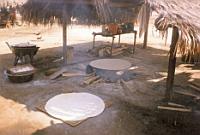
Food Gathering
When the clay was broken open, feathers or scales came with it. Boiling was not so common except for crabs. Crabs were cooked in a pot with little water and much red pepper, the whole being covered with leaves. Fish, half gutted and with scales left on, were also cooked this way. No salt was ever used.
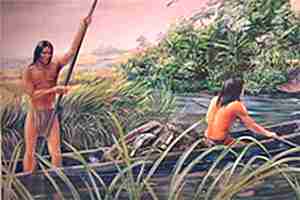 Mainly fishermen, the Amerindians we know as the Caribs and Arawaks, geared their lives to the bounty of the land and sea. Digging sticks were used for planting gardens and fire was used for forest clearance. Line fishing was carried out with shell and turtle shell hooks. The thread was made from pineapple, dagger tree and other fibers.
Mainly fishermen, the Amerindians we know as the Caribs and Arawaks, geared their lives to the bounty of the land and sea. Digging sticks were used for planting gardens and fire was used for forest clearance. Line fishing was carried out with shell and turtle shell hooks. The thread was made from pineapple, dagger tree and other fibers.
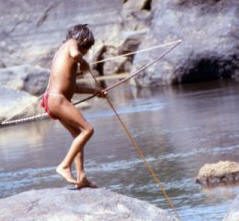 Fishing
Fishing
Fish were shot with the bow and arrow from the rocks and then retrieved by diving. They were often inebriated first using a certain beaten up bark of a tree( Piscidia sp.) Nets were made of palm fibre or cotton. Rocks were taken to dive for lobsters and for conchs.
Turtles were caught by slipping a cord around their flippers and by harpooning. Crabs were searched for at night by using torches made from Torchwood. Pelicans and kingfishers were tamed to fish for them. Hunted were: Rice-rat, birds, iguana, snakes, worms, insects, spiders.
Birds were shot with an arrow with a wad of cotton on the end instead of a sharp head. Birds were trapped in small traps and also by a strong glue from resins. Parrots were gassed from fires lit under trees in which gum, green pimentos or peppers were burnt.
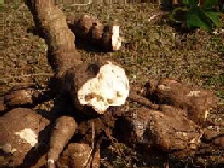 CASSAVA
CASSAVA
This root vegetable(Manihot esculentas) was the main staple of the Amerindians. The Cassava plant grows easily, but is a factor of soil degradation. This is probably the reason why the Amerindians moved slowly up the Lesser Antillean chain when they left South America at about the time of Christ.
Cassava kept and travelled well in ocean-going canoes. After processing, it produced flour, bread loaf (6 ins thick) and several other varieties, a sauce called cassareep and a wine. As a vegetable it was light on the stomach. It was cooked over a fire on a griddle.
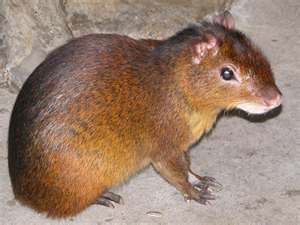 PROTEIN
PROTEIN
AGOUTI (Dasyprocta aguti) was a dark brown rodent that lived in Antigua about the size of a rabbit, and was introduced from South America. Agouti were hunted by non-barking dogs. It was kept for a day as it was too gamy, then it was salted, smoked and boiled in cassava juice for a long time to tenderize it. The guinea pig (Cavia porcellus) was another mammal occasionally used as food.
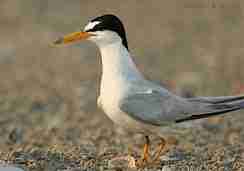 Terns
Terns
(of the family Laridae) Larger birds, like Terns, had their wings cut half off and were turned in the fire to burn off the feathers. They were then left on a grill to smoke. Common Tern is a marine bird related to Sea gulls, but smaller with long pointed beak, wings, and forked tail.
Small birds were wrapped in leaves to cook slowly. The outer skin was peeled off and the guts taken out. They were eaten without a sauce. Sometimes small birds were boiled in cassava juice with peppers, they had been smoke-cured, then drawn and feathered. Flamingos and parrots were aboriginally present in Antigua and were prized for their flesh and colorful feathers.
Reef Fishing
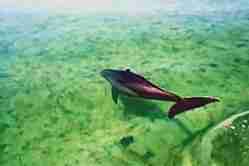 Fish was boiled in fresh water, often half cleaned without being scaled. It was
sometimes roasted on a spit. Fish was seasoned with peppers. Sea food was kept alive in
corrals until needed, this was a common food storage method. Crabs were a delicacy. Many different species of crabs and shellfish have been found archaeologically in kitchen middens (garbage dumps). Conch and whelks appear to be the commonest in most village sites.
Fish was boiled in fresh water, often half cleaned without being scaled. It was
sometimes roasted on a spit. Fish was seasoned with peppers. Sea food was kept alive in
corrals until needed, this was a common food storage method. Crabs were a delicacy. Many different species of crabs and shellfish have been found archaeologically in kitchen middens (garbage dumps). Conch and whelks appear to be the commonest in most village sites.
PEPPER POT
The Peperpot was called Tomali (Toma Sauce, ali clay pot). This method of cooking was a ingenious type of food storage. A rich brown pungent sauce was made by boiling any or all of the following available items. Fish heads, bones of fish, agouti, rice rat (Oryzomys spp.), iguana, birds, monkey, seashells (chip-chips, oysters, whelks) into a deep clay fire pot with peppers, sweet potatoes, cassava juice and fine cassava flour. Cassava bread and other meats were dipped into this stew. It was boiled continuously and added to next day. Father Breton noted that it was rather unhygienic (even by 17th century standards!) as often roucou (body paint) and old women's hair was always found in pepper pots.
VEGETABLES AND FRUITS
Maize (corn) was roasted on coal and maize cakes, Kayzu, were made by boiling. Green maize soup was also made. Other vegetables were. Yams Kuchu, beans Mankonti arrowroot baked, Carib Cabbage Taya was used as a seasoning. Peanuts were eaten with cassava. Some fruits were the pineapple, introduced from South America and the native coco plum (Chrysobalanus icaca L.) Native seaside grapes and the fruits of the prickly pear cactus were also eaten as well as many other introduced plants as avocado, soursop, guava, paw-paw and mamey.
DELICACIES
Delicacies were raw fish eyes and the entrails of the sea-cucumber were sucked out. If food was short, these holothurians were rubbed in the ashes of a fire to rid them of their slime and then cooked. Another delicacy was
lice, particularly those from the heads of their enemies, these were rolled between the teeth
for a quarter of an hour to savor. Toads (houa), snakes, worms and insects were also eaten. The Amerindian thus exploited natural resources to the maximum. They were very fond of honey.
BEVERAGES
The main alcoholic drink was cassava wine, Wi'ku.This was a heady drink made from cassava and sweet potatoes fermented in syrup and water "Gossiping old women" chewed and spat out the cassava which was fermented in pots. A beer was made from maize Pallino, and pressed pineapples were used.
The juice was probably left to ferment as a wine. A soft drink was honey and water Maba, and another was made from the cooked roots of the Carib Cabbage. An unknown plant calledKarratas was used to make a drink to quench the thirst when far from water. During the European contact period, the Caribs pounded sugar cane in a pestle and boiled it to make a drink.
RECIPES
Tacallalaca throw into a pot the bones of a fish just eaten, add handfuls of red pepper, cassava water and very fine cassava flour and a few pieces of crab stirring the whole with a flat-ended stick. Hot sauce. Make from boiled cassareep juice and squashed pimento. Lime juice was included after European contact. Plants played an essential part in the daily social and economic life of the early islanders.
A plant-based culture provided the early people with food, utensils, ornaments and drugs in fact materials of all kinds. To say the least, Antigua and Barbuda's environment was fully exploited. The early islanders brought with them from South America their principal useful plants, without which they would have had to rely on the scarce resources of the natural flora and fauna of the Lesser Antillean Islands.
